Setting Sensible Targets For Your KPIs
by Stacey BarrKPI target setting is both science and art. Science, in that it has proven and logical steps. Art, in that it needs your own creative input too.

Target-setting is rife with worries like being achievable versus stretch, motivating people to pursue them, figuring out how to measure them, the consequences of missing them, how hard it will be to reach them. So we often back away from them.
However, targets can give so much more power to performance improvement when they’re done well. So, to make it easier to blend and balance the science and art of target-setting, here is a how-to process to help you find the true power of targets.
STEP 1: Start with enough KPI values.
Make sure your performance measure can be monitored frequently enough within each target timeframe. We need enough data to detect real changes in performance. Two points of data tells us nothing. We need to start with a baseline from at least 5 measure values.
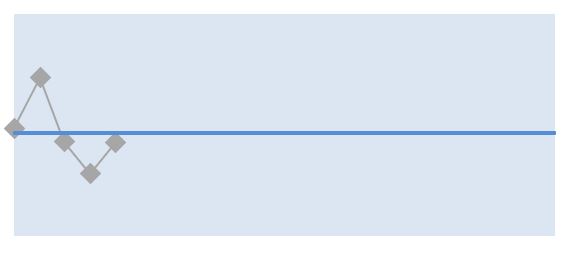
After the baseline, we usually then need another dozen or so for signal detection; to know if any shift in performance toward the target is real or just random. So, design your measure so you can calculate it as regularly as is feasible. We call this a KPI calculation cadence. Then, set a target timeframe far enough into the future so you get sufficient feedback about how the KPI is tracking toward that target.
For example, monitor your measure weekly or monthly for a 1 to 2 year target timeframe. Yes, sometimes you just can’t get data this frequently, but that doesn’t change the fact that a single point of data says nothing.
Having enough KPI data is the beginning in setting a target we can convincingly know is achieved or not. And another contributor to that is the way the KPI data is presented.
STEP 2: Use a chart that makes the performance gap clear.
You haven’t hit the target just because this month’s KPI value is at the target. You don’t have to wait until the end of the year to see if your KPI has hit the target. Good targets are about ongoing capability, not one-hit wonders or too-little-too-late evaluations.
Understanding performance gaps is the key to improvement, and the key to understanding performance gaps is knowing the real difference between as-is performance and to-be performance. And the chart we use for our KPI can make this visually confusing, or visually crystal clear. It’s the XmR chart:
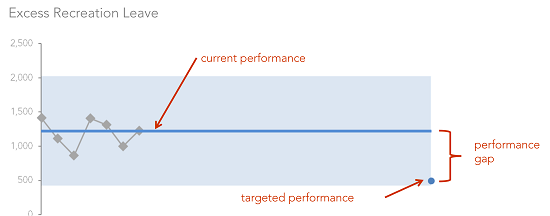
If you use an XmR chart, you can have three types of useful KPI targets to help you get more control over performance:
- the average level of performance (like average customer satisfaction)
- the variability (or predictability) of performance (like keeping spending within 10% of budget)
- a threshold of performance (like keeping up-time above 98%)
You can use one or all of these types of targets, depending on the nature of improvement you need in your KPI. And that might mean you need to think a bit about what that improvement might involve.
STEP 3: Scope “how to” before “how much”.
If you and your team do not yet possess the target setting and achieving prowess of an Olympic athlete, then avoid setting any kind of target without first exploring a range of ideas of how you might go about achieving it.
We set targets to lift the performance of our work outputs and outcomes, but it takes work to shift the capability of the work processes that produce those outputs and outcomes. If we’re not familiar with how our processes work, it might take more effort to improve them than we might expect. Or perhaps less. But understanding our processes first, helps us know better.
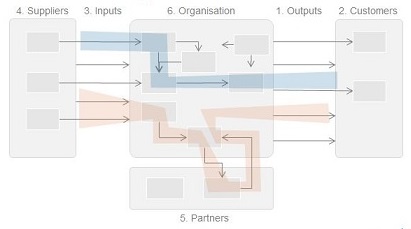
Another manager I know used simulation software to model his business processes (for moving freight). He made changes in the model to simulate changes like more equipment, different procedures, and changing policies. So before he spent a single dollar, he got a good idea about which strategies would best hit the targets. He saved his company many millions of dollars of investment in new trains that weren’t needed, because he explored how to redesign the process.
The depth of understanding we can get about our processes, and what it might take to improve their performance, helps us decide on exactly what target to set.
STEP 4: Don’t decide on achievable or stretch – use both.
What I’ve learned is that it takes practice and confidence-building to achieve a target or goal. If we set just one target for a KPI, we hit it or miss it, win or lose, succeed or fail. Targets should inspire improvement, not judgement.
Why not set at least two or three targets for any single performance measure? We call this a target trajectory, and it can look like this:
- The first target is shorter term and not very challenging, for the purpose of building target-accomplishing momentum.
- The interim target is an opportunity to build more capability and confidence to stretch.
- The last target is the stretch target, which you might have no idea of how to reach at this point in time, but trust you will be in a better position to know after you’ve learned from the interim target.
Notice the three blue dots in this XmR chart of Daily Farm Profit, set as a trajectory towards significant improvement:
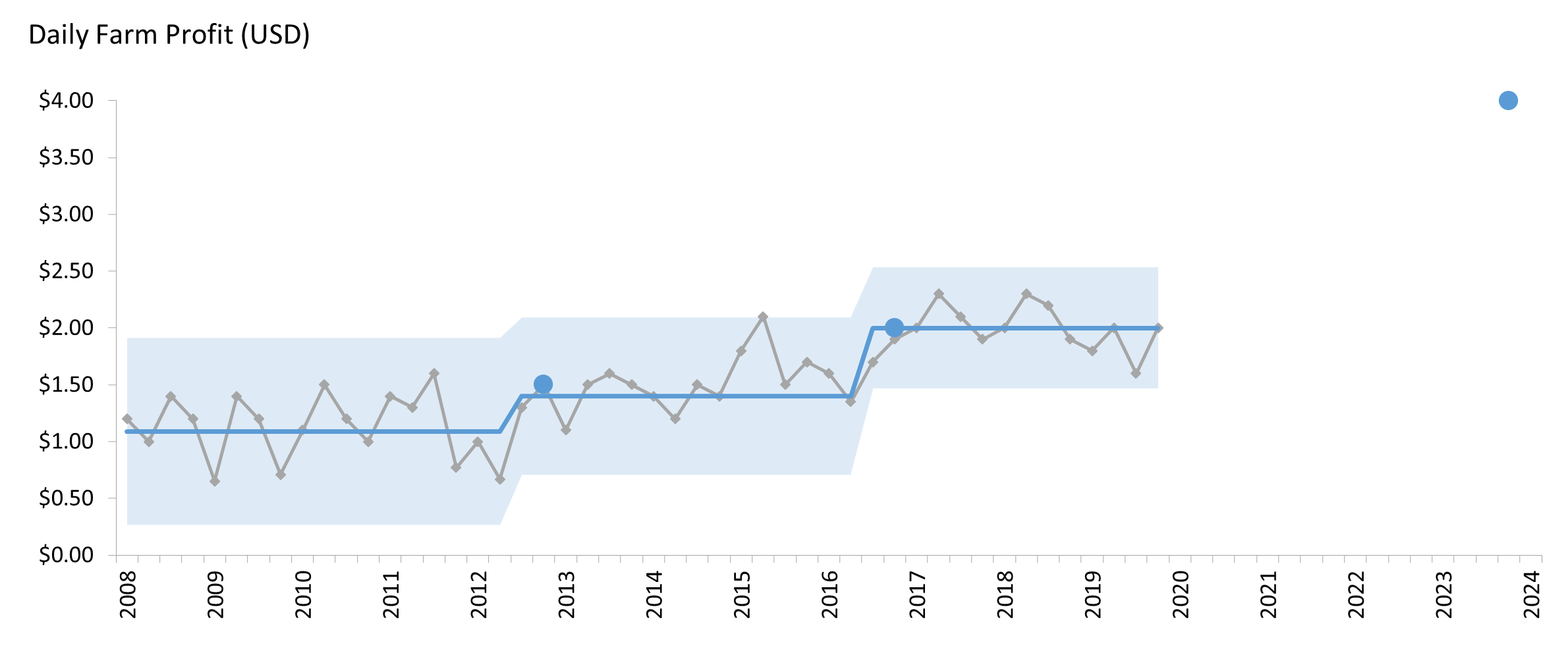
Using a target trajectory like this also helps people feel more psychological safety in pursuing performance improvements. No target will improve performance unless people feel motivated to pursue it.
STEP 5: Motivate the wider team to pursue the target.
Numbers alone are hardly enough to motivate anyone. So handing a team a performance measure with a target and timeframe won’t likely be enough motivation. For anyone to move away from fear and toward motivation for a target, three conditions need to be met:
- Support – to get what’s needed to reach the target.
- Buy-in – to feel ownership of the target.
- Belief – to trust they are able to reach the target.
Have you ever tried telling the story about what the world (or at least your part of it) is like after the target is met? Colour, sound, movement, emotion, expression, behaviour, shape, rhythm and all those other sensory experiences is one way to emblazon the meaning of the target into the minds and hearts of those setting out to achieve it. Motivation from within is the best kind.
[NOTE: This step might be important enough to move to step 1 of this target-setting process.]
Part of that rich, vivid story of the intent of achieving the target should be the other important dimensions of performance that might be touched by that target’s pursuit.
STEP 6: Keep an eye on the bigger picture.
The system of KPIs or performance measures of any organisation do not work in isolation of one another. As in the universe, everything is connected to everything, it’s the same with KPIs – they are interdependent with each other.
I once heard a story about a railway organisation that prioritised on-time running over all other performance outcomes. One day, due to the train running late, the driver omitted an important safety check to save time. The train derailed because of a braking problem that the safety check would have picked up.
Even if you had enough foresight to explore the unintended consequences of achieving your target, before you locked it into your plan, the world can still change tomorrow. If not tomorrow, then next month. Every now and then, ask yourself “Is reaching for this target still a good idea?”. And a great tool to help you do this is the PuMP Results Map. It visually maps that bigger picture, and makes it much easier to see the consequences that a target can have on related KPIs.
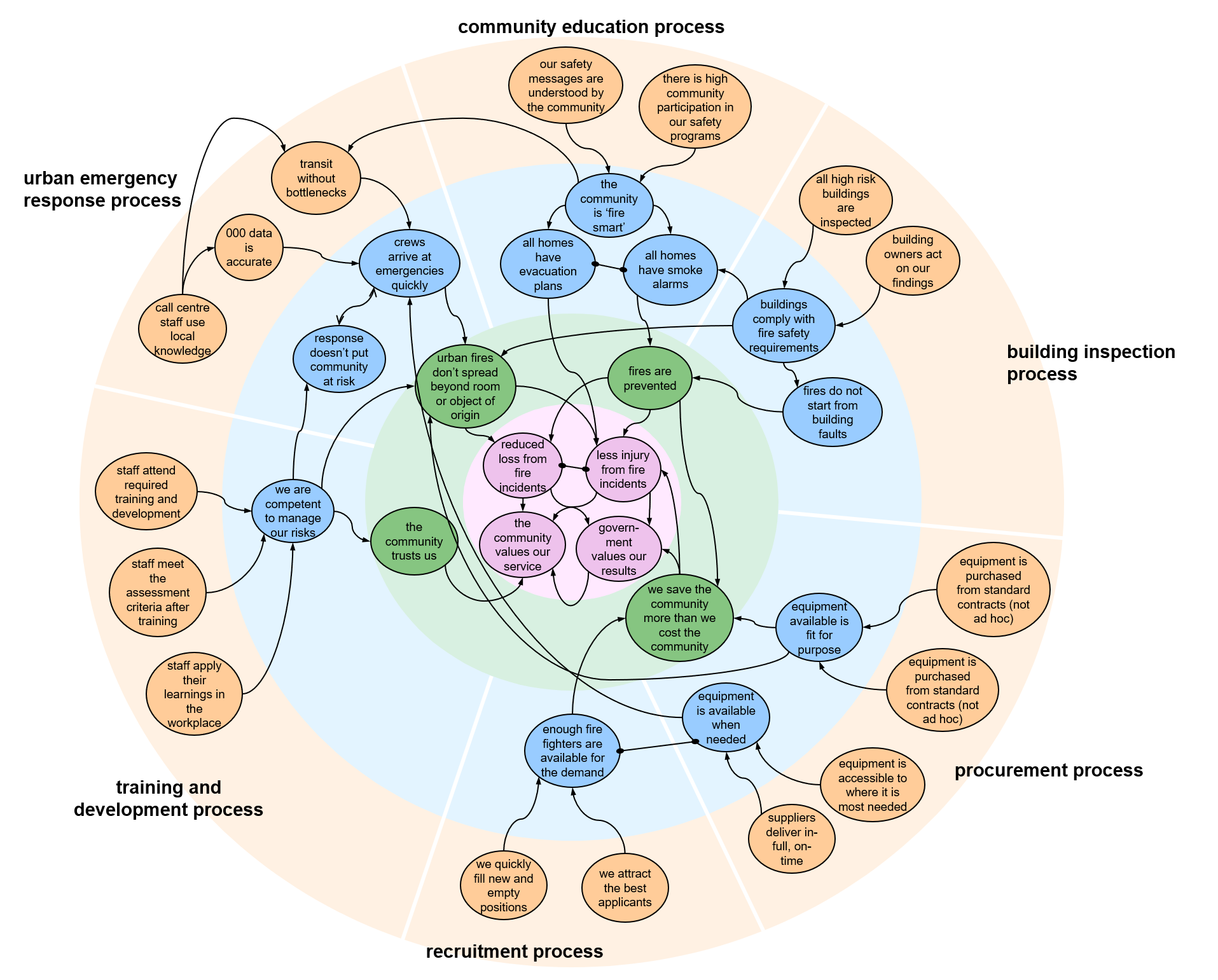
You may have noticed in this example Results Map, the results are mapped by business process. That’s because process improvement is the key to reaching targets.
STEP 7: Pursue the target through process improvement.
We’re doomed to fail if we think that hitting targets is the result of working harder or faster. We do talk about working smarter, though. But what exactly does that mean? It means thinking about working on our processes and not just working in them.
Lean Six Sigma, Agile, and many other improvement methodologies take this same approach to working on our processes to improve performance. Just like this team did, with their billing process:
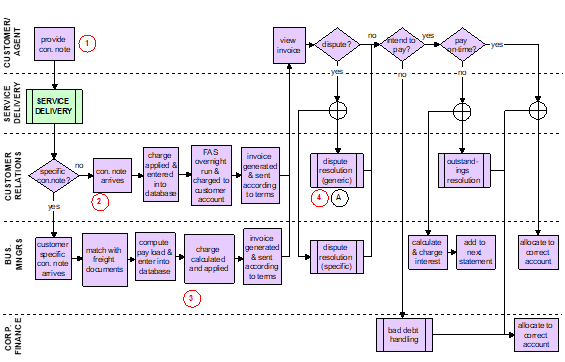
The letters and numbers in circles are the team’s diagnosis of problems in the process design that affect their ability to achieve targets for measures like Customer Satisfaction With Invoice Accuracy and Bad Debts as a % of Revenue. In other words, to improve performance and reach for those targets, these problems need to be designed out of the process. We call this a fundamental performance improvement because it generally means fix it once, without having to continue to compensate for under-performance.
We come up with a few solutions, no doubt, to fix problems in our process design. And then we need to test them, to know if they’ve closed that performance gap and moved the KPI closer to its target.
STEP 8: Know exactly if, or if not, a target has been reached.
Up in STEP 1, we’ve already talked about how we haven’t hit the target just because this month’s KPI value is at the target. That’s because that single KPI value is subject to normal and random variability, and is never a precise and exact measure of performance.
That’s why we need to measure frequently enough, and use several points to decide if a target has been achieved or not. It’s too easy to misinterpret a KPI if we ignore variability. Notice all the variation in the following measure, but how we can still see improvement has closed the performance gaps and reached the first two targets:
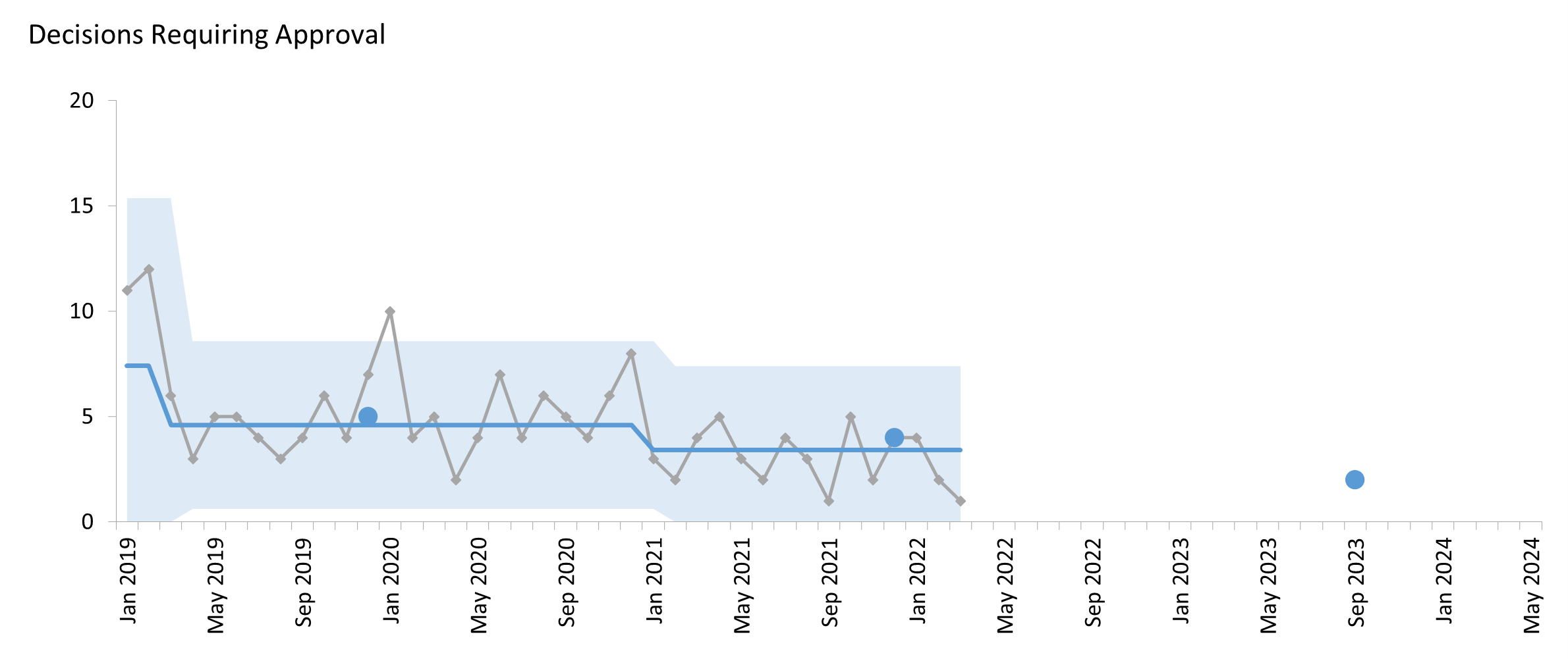
Logically, there are really 7 specific signals a KPI with a target can give us. These are based on permutations of the KPI’s direction of change and speed of change relative to its target.
Whether we reach a target or not, we have the opportunity to learn what works and what doesn’t. And that’s the ultimate benefit of reaching for KPI targets.
STEP 9: Learn from every single target.
If you achieve every target you ever set, then you aren’t challenging yourself enough. You’re staying inside your comfort zone, inside of what you know works, what you know you can accomplish. That’s not what improvement is about.
If we want to jump over a creek without getting both feet wet, then we don’t aim for the far bank of the creek. We aim for a metre or so beyond it, further than we think we can reach. That way, maybe only one foot will get wet. Somehow, our strides are longer and stronger when our eyes focus further ahead. In any case, we’ll learn.
There is no learning without failing, and no improvement without learning. Sure, we can learn a little bit from success, but the richest learning comes from our fearless experimentation. Of course, this requires a culture of psychological safety, and target-setting is a great context for us to start practicing ways to nurture it.
Does that help?
Connect with Stacey
Haven’t found what you’re looking for? Want more information? Fill out the form below and I’ll get in touch with you as soon as possible.
167 Eagle Street,
Brisbane Qld 4000,
Australia
ACN: 129953635
Director: Stacey Barr




